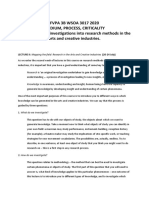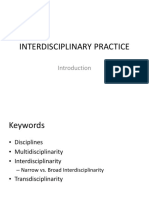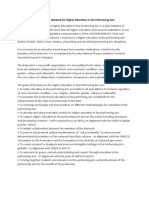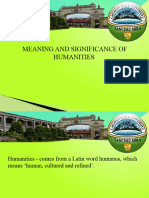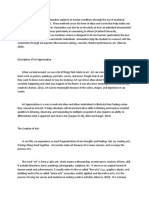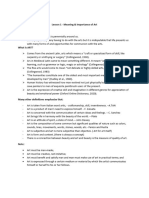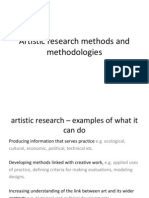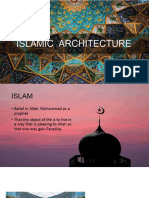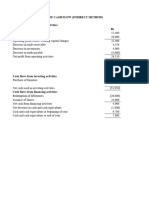FOA 201 (THE ARTS AND OTHER DISCIPLINES)
NEXUS BETWEEN THE ARTS>HUMANITIES AND OTHER DISCIPLINES
The Arts, by their nature, are interdisciplinary. From their inception, the arts are an integral part
of the social glue of a society or community, hence they are referred to as “The Humanities”.
Everyone participates in the Arts which remain an essential ingredient in the social community.
The arts taught them of their past, reflected their present, and shed a light on the future. The arts
communicate the human experience (Anderson, 1995). Experiencing the arts as one component
of many within an educational context is relatively new. The disciplines of art and music history
as we know it today in higher education came into being in the nineteenth century. Additionally,
post-modern critical approaches to the arts adopt approaches from many other disciplines such as
economics, political theory, women’s studies, psychoanalysis and sociology thus strengthening
their interdisciplinarity. In short, the arts express the human experience in all of its facets and
thus can be linked to all other disciplines. Consequently, the arts and other disciplines can easily
be linked together in many teaching scenarios. Davis (1995) provides a list of over one hundred
interdisciplinary courses taught across the globe. A reader’s perusal through this list
demonstrates the initial ease with which the arts can be combined with virtually any other
discipline.
However, the arts, this ready-made interdisciplinary glue, may suffer the loss of their own
integrity as disciplines in all levels of education. Scholars have assessed the effects of
interdisciplinarity on the arts disciplines. Educators call on the arts to be bridges for all other
disciplines but warned that in doing so, the arts can become merely simplistic illustrations
(Roucher and Lovano-Kerr, 1995). In this way, the arts may lose their own unique thinking skills
and scholarly language by being absorbed into a multi-media blitz. Thus, the arts’ future may
involve a struggle to maintain themselves as disciplines.
Hence, the arts must be treated as an equal with all other disciplines. The authors of the
aforementioned article support professional staff development and team teaching approaches to
help attain this goal. Dunn (1995) alludes to points that aid the arts as an interdisciplinary
component in integrating the arts: Renaissance and reformation in arts education.
1
�First, the arts require experts in their respective fields. An anatomy teacher does not necessarily
have the ability to teach Dr. Tulp’s Anatomy Lesson. Like mathematics or science, the ability
and skill sets necessary to teach the arts are not innate. The arts should be taught by an arts
teacher or by someone appropriately trained in that specific discipline.
Second, lessons should be gradated moving from a simple to a more complex understanding of
the multiple dimensions of the discipline and they should be reinforced throughout the other
disciplines.
Third, courses in the arts have traditionally been aimed at, and even reserved for, the gifted
minority. Dunn suggests that one goal for the arts in interdisciplinary studies should not be the
production of a minority. It should be the fostering of a majority of appreciators. Irwin and
Reynolds (1995) in Integration as a Strategy for Teaching the Arts as Disciplines discuss four
major epistemological positions on integration with attention to what these positions suggest
regarding possible pitfalls for arts integration.
The first position states that all knowledge is essentially unified. Given this maxim, students may
not perceive that the arts have their own progressive, sequential knowledge base or employ their
own unique thinking skills.
Second, all knowledge can be categorized into a few large thought constructs. This concept
might suggest a limitation on the possible connections made within the arts disciplines and
outward to other disciplines.
The third position encourages students to make their own connections among disciplines and
frequently employ the inquiry method. Students using inquiry without an adequate knowledge
base may make incorrect or inappropriate connections.
The fourth epistemological position suggests that there are intricate conceptual relations between
the disciplines. The authors have no notes of caution regarding this fourth position however an
overemphasis on these conceptual connections may lessen the uniqueness of each discipline.
Parsons’ article titled Integrated Curriculum and our Paradigm of Cognition in the Arts is a
milestone in the discussion of the arts and interdisciplinary studies since it deals with cognition
in the arts, specifically calling into question the usefulness of the prevailing theory, the symbol
systems approach. He rethinks this dominant thesis. This approach to cognition “identifies the
2
� different arts as each being a different symbol system, and thinking in the arts as processing, or
conducting operations on, the symbols of one of these systems.” (Parsons, 1998, p. 105) Thus in
this paradigm, since it forges a specific cognitive language for each of the arts, an artwork’s
meaning is unique to itself, that is, its meaning is not completely translatable to any other
medium. In other words, the meaning of a painting for instance can only truly be found in the
painting itself, or at least only within the medium of it, and not, for instance, in a written
description of the painting. Parsons believes that this paradigm isolates the discussion of a given
artwork solely to its own medium, thus separating it from other disciplines and consequently
thwarting attempts at an integrated curriculum. The author then promotes an “interpretive
account, that is, imprecise, multi-layered, volatile, always in process of translation, never
precisely fixed in meaning” (p. 115) but that truly allows the arts to interact with culture and thus
integrate with other disciplines.
Approaches to Pluralistic/Collaborative Research
Arts and Humanities and its complex questions cannot be effectively addressed through a single
disciplinary lens (i.e., monodisciplinarity). This is also true of all other disciplines such as
Sciences, Social Sciences, Pharmacy, Engineering and so on. To study any discipline from only
one perspective would be to overlook the advantages and nuances introduced by alternative
viewpoints. Theories, questions, insights, and understandings held by other fields shed light on
the extant knowledge currently understood in the Arts. There are a variety of ways that research
is approached pluralistically:
a) Multidisciplinarity
b) Interdisciplinarity
c) Transdisciplinarity
All three modes of collaboration serve specific purposes and manifest differently (Choi & Pak, 2006).
Over the years, the terms have been used rhetorically and interchangeably; however, understanding the
differences between them is important to put them to best use.
Multidisciplinarity: Multidisciplinary research consists of a collaborative team of researchers from
different fields who examine a similar, broad question. They may come together at various points in
the process, but for the most part they examine a similar topic of interest from their own disciplinary
3
�lens, reach their own conclusions, and disseminate their results to respective outlets
(Rosenfield, 1992). Hence, the team may come together at the end to present a synthesized output of
their individualized results; however, the narrow perspectives through which questions are examined
throughout the research make it a modest attempt at collaboration.
Diagram Showing Multidisciplinary Research
Interdisciplinarity: Within an interdisciplinary model, researchers inform each other’s perspectives
and compare results through a transfer of knowledge across disciplines (Gehlert, Murray, Sohmer,
McClintock, Conzen, & Olopade, 2010). According to Nicolescu (1997), this process may lead to the
creation of an entirely new discipline or area of scientific inquiry; for example, social psychology,
bioengineering, and anthrozoology emerged this way. However, McGregor (2004) contended that
even though members of the research team are contributing to the process, they are still grounded in
their root disciplines.
4
�Diagram Showing Interdisciplinary Research
Transdisciplinarity: In Transdisciplinary research, investigators step outside the boundaries of
their known areas of inquiry to create “its own intellectual space” (McGregor, 2004, p. 2). The goal
here is to truly blend different perspectives so as to understand certain questions and problems in
their complexity rather than just addressing pieces of them. Gehlert et al., (2010) contended that
although members of a research team may be informed by their core disciplines, “the
transdisciplinary approach allows them to transcend and operate outside the boundaries and cultures
of those disciplines to capture new realities, mutually inform one another’s work, and address
multi-level determinants…” (p. 412).
To successfully achieve Transdisciplinarity, researchers must communicate well by sharing
knowledge and lexis, as well as agree on research design and analyses (Gehlert et al., 2010). In
summary, all members of the team must mutually respect what the other brings to the proverbial
table by putting idiosyncratic disciplinary agenda aside and must value the individual contributions
in the effort to address multifaceted problems and find solutions.
5
�Diagram Showing Transdisciplinary Research
In considering the three definitions and their respective purposes, Choi and Pak (2006) further
described the differences using food as an analogy. In this instance, they likened Multidisciplinarity
to a salad (where different foods come together but maintain distinct identity), interdisciplinary to a
melting pot like a stew (where components are married to create something different but individual
ingredients are still identifiable), and Transdisciplinarity to a cake (where ingredients are combined,
but the final product is something completely new and the ingredients are, for the most part,
indistinguishable).
The reward and robustness afforded by combining scientific perspectives has increased in
frequency in
the past decade (Wuchty, Jones, & Uzzi, 2007), and it does present challenges that make it
difficult to achieve. Transdisciplinarity is thought to be the most effective at addressing complex
problems, but it is the most problematic. This is due, at least in part, to traditional models of higher
education,funding, societies, and journals that reward individual achievement and depth within a dis
cipline rather than breadth (Adler & Stewart, 2010; Gehlert et al., 2010). That said, efforts on the
parts of institutions and administrators, professional societies, and funders such as the National Insti
tutes of Health are providing more opportunities for rewarding collaborative research.
6
�Thus, for interdisciplinary and particularly Transdisciplinary collaboration, it is important that the
perspectives of the contributing fields are equally valued and respected, not dominated or
undermined.
THE ARTS/HUMANITIES AND ENGINEERING
As the world becomes more connected and globalized, the problems that engineers are called
upon to solve are increasingly complex and interdependent. Research on engineering work has
suggested that professional engineers address open-ended, ill-structured problems that are
situated in specific contexts (Bornasal et al., 2018; Stevens et al., 2014). Unfortunately,
engineering coursework has traditionally focused on abstract and closed-ended problem solving,
offering few opportunities for students to develop these skills (Jonassen, 2014). The unique,
situated contexts of engineering problems and projects require that engineers think and work
across a wide range of cultural, disciplinary, and organizational differences (Jesiek et al., 2015,
2017). This ability can be described using the theoretical framework of systems thinking, which
emphasizes the need to consider both technical and contextual variables when solving problems
(Grohs et al., 2018).
Systems thinking is the ability to see the world as a complex interconnected system where
different parts can influence each other (Senge, 2006; Sterman, 2000). Systems thinking can be
developed via exposure to complex systems and similar interventions (Peterson et al., 2018).
Hence, integrating engineering with the humanities help students develop a better understanding
of contextual influences in engineering work as operationalized through the lens of systems
thinking. We therefore see the importance of integrating the humanities and engineering in order
to understand the multiple and intersecting layers of context in an engineering project.
Engineering is a field of study that applies science, mathematics, and technology to the existing
world. As an applied field, it is inherently connected to the human experience in a variety of
ways, and thus requires a multidisciplinary approach (Exter et al., 2017; Hynes & Swenson,
2013; Pavlica et al., 2020). The humanities provide understanding of the human experience
(National Foundation on the Arts and the Humanities Act, 1965).
Building an understanding of these fields under Humanities into engineering can lead to a wide
range of potential benefits. On an intellectual level, experience with humanities topics and
7
�methods can lead to intellectual flexibility (Shumway, 2017) and deeper understanding of current
problems and possible solutions faced by engineers and other professionals (Kitch, 2017).
Developing a humanities-based perspective can also practically support engineering design
work, informing professionals’ abilities to solve social problems (Benneworth, 2015), their
ability to consider unintended consequences of engineering projects (Fila et al., 2014), and their
preparation to be an engineer who works for people and with people (Hynes & Swenson, 2013).
Otsuki (2018) advocates for an understanding of the intersection between the humanities and
STEM (Science, Technology, Engineering and Mathematics) because it is at this intersection
where new knowledge and products are created.
Lastly, humanities education can have positive effects on other professional skills such as
communication, interpersonal, and intercultural skills (Edmondson et al., 2020; Pavlica et al.,
2020). For all of these reasons, integrating humanities topics and approaches can enhance the
engineering curriculum.
Framework for the Intersection and Integration of Humanities and Engineering
Hynes and Swenson (2013) provide a framework defining the intersection between engineering
and the humanities. This framework describes two perspectives through which to view the
connections between engineering and the humanities: engineering for people and engineering
with people. Fila et al. (2014) add an additional perspective to the framework: engineering as
people. The engineering for people perspective highlights the broadening group of people who
are impacted by an engineer’s work, from individuals to communities to nations to the world.
The engineering with people perspective focuses on engineers’ work within diverse teams and
across diverse stakeholders, including the consideration of unique individuals, teams,
corporations, and multinational corporations and governments (Hynes & Swemson, 2013). The
engineering as people perspective addresses the need for engineers to understand their own
identities, knowledge, skills, beliefs, and values (Fila et al., 2014). Because of the variability in
the human experience and the need to consider human factors ranging from the level of
individuals to global dynamics, Hynes and Swenson (2013) assert that “the humanistic aspects of
engineering make engineering quite difficult to practice” (p. 32). Understanding engineering for,
with, and as people is a useful framework to help students and engineers consider the
intersections between humans and engineering.
8
�Building on this existing framework we understand the need to consider context within
engineering work. Hence, when considering any type of human-engineering interaction,
engineers must understand the context in which their project is situated, including influences at
the levels of the individual, community, corporation, nation, government, etc. When focusing on
a given population’s connection to an engineering project, engineers must have highly
specialized information about the specific population within the local and global context to
accurately incorporate a contextual analysis into their thinking about the problem. Hynes &
Swenson (2013) and Fila et al. (2014) perhaps allude to this notion when they address the need
for the humanities, but the concept requires clarification if it is to be implemented in pedagogical
initiatives. Humanities factors are specific to a given human or human group (e.g., individual,
community) and these factors intertwine to create the context of an engineering problem. The
humanities areas of study provide the idea of the various knowledge sets that an engineer may
need to understand the context. This understanding of context informed the design of the
humanities-informed engineering course.
THE ARTS/HUMANITIES AND MEDICINE
The arts and humanities contribute immensely and immeasurably to medical education and the
field of Medicine in general. As different ways of knowing, sharing, and meaning-making, the
arts and humanities strengthen the understanding, inspire compassion and creativity, and
stimulate cognitive capacities within the medical field.
The arts represent complex ideas, o1ften conveyed with simplicity and aesthetic frisson, and
generate interpretations and analyses that may stretch far beyond the original intentions of the
artists. The humanities allow us to connect across time and cultures, to recognize patterns of
consequence, and to self-observe and reflect. Enriching our experience, the arts and humanities
connect us with the lives and perspectives of others, proffering fundamental insights into illness
and suffering, health and healing. For these and other reasons, integration of the arts and
humanities into medical education is worthy of our attention and commitment.
The integration of the arts and humanities and other disciplines into medical education is a
deliberate decision. This decision honors creativity, compassion, critique, and connection.
Importantly, this decision is informed by a view that all human knowledge is interconnected,
9
�generative, at times irreducible, and always incomplete, a lesson of significance for academic
medicine.
The humanities and even the social sciences are important aspects of everyday medical practice,
and they are usually incorporated early into medical education. The General Medical Council
emphasizes the importance of understanding a patient’s psychological, social and cultural needs,
alongside their pathology.
Extending medical education beyond the biomedical sciences and clinical skills is a core strategy
in the development of professional values and behaviours, including professional identity
formation. Hence, medical humanities may encourage a deeper understanding of patients’ illness
journeys through promoting cultural inclusivity by use of longitudinal case studies. For instance,
the Arts can nurture visual diagnostic and analytical skills, be an outlet for physicians at risk of
burnout and nurture the positive qualities of empathy, self-efficacy and efficient patient focused
care. The humanities may also support the development of interpersonal skills required to take
on leadership and management roles within the multidisciplinary team. Physician-led healthcare
management has been shown to result in better performance financially and clinically.
Humanities-based learning may also support the development of persuasive writing skills which
support engagement in policy writing and global heath. Some essential tools needed to
accomplish these are the humanity subjects of history, economics, law and sociology.
Many medical schools have introduced humanities-based courses into their curricula, which may
be centering around poetry, prose, law and ethics. However, these elements are often elective in
nature, predisposing to self-selecting students, which may bias follow-up surveys and questions
to more positive outcomes. These humanities are often introduced as isolated courses rather than
integrated education, shying away from the holistic approach a modern doctor should embody
and therefore prompting courses to be centered on the biomedical aspects of medicine. Similarly,
few studies have questioned how medical students would like the humanities integrated into their
education, and their engagement with the humanities outside of these compulsory programmes,
with little regard towards the temporal placement of these courses within the field.
However, by integrating arts and humanities throughout medical education, trainees and
physicians can learn to be better observers and interpreters; and build empathy, communication
and teamwork skills, and more
10
�THE ARTS/HUMANITIES AND SCIENCES
Integration of teaching and learning in higher education inevitably takes place within the
context of disciplinary pedagogies, content, and epistemologies. Disciplines have their own
ways of looking at the world, of making meaning and discovering truth. But these approaches
are pragmatic, meant to arrive at certain human ends. The disciplines delimit their objects of
study; their theoretical approaches, projects, and traditions; the forms of evidence,
interpretation, and explanation that are appropriate to them; and the professional and
institutional structures through which these parameters are articulated, regulated, taught, and,
in effect, enforced. The disciplines are self-reinforcing, and disciplinary specialization and
fragmentation have intensified as the disciplines have strengthened and solidified. Every field
of study has its own epistemology that is learned through disciplinary preparation. The process
of disciplinary education is characterized by certain conceptual gateways that are preconditions
to any deep disciplinary understanding.
The humanities teach close reading practices as an essential tool, an appreciation for context
across time and space, qualitative analysis of social structures and relationships, the
importance of perspective, the capacity for empathic understanding, analysis of the structure of
an argument (or of the analysis itself), and study of phenomenology in the human world. The
sciences teach “the use of evidence to construct testable explanations and predictions of natural
phenomena, as well as the knowledge generated through this process ”. Integration can take
multiple forms and can range from a relatively superficial intersection of disciplines to a deep
integration of disciplinary knowledge. Often this range is characterized by the terms
multidisciplinary, interdisciplinary, and transdisciplinary .In addition to integrative general
education, global education can offer opportunities for building integrative competencies.
Going further, let us quickly and summarily look at some of the characteristics which science
and the humanities share, and at the same time in which they differ. First, science and the
humanities differ in the subject of their studies and methodologies used. Whereas the subject in
science is rather concrete and instruments for its solution are experiments, observation,
calculation and modelling, the subject in the humanities tends to be rather abstract and logic
contemplation and thinking may serve as instruments. However, both science and the humanities
share a quest for knowledge and the truth, defining and tackling a problem, a question, and trying
to resolve it.
11
�Second, science and the humanities may differ in their language. Various branches of science
have their own language which is usually understandable only to scientists from the same
community. While the humanities may also have their own language, this language is usually
more communicable to the lay public. Moreover, scholars in the humanities, in disseminating
their knowledge, often create a work of literature. Hence scholars in science should learn from
those in the humanities how to make themselves more comprehensible and how to disseminate
their findings and knowledge to public.
Third, science and the humanities may differ in credibility; the humanities are more vulnerable to
political pressure. Credibility of scholars in science is based rather on true, repeatable results be
they presented in graphs, statistics or pictures rather than on words and interpretation. The results
speak for themselves. On the other hand, scholars in the humanities need to be exact in their
wording, expression and interpretation, as it is the word itself which makes them credible in their
own community. This need for the exact and mostly also for literary expression is probably the
reason why, in our experiences, we see scholars in the humanities prefer to read their papers at
conferences whereas scholars in science tend to extemporise. It is obvious that science and the
humanities share one ultimate necessity: credibility of the scholars in their own communities and
in the whole society. But science and the humanities also share a danger. Results of scholars in
science may be misused if society is not democratic, and theories of scholars in the humanities
may be dangerous to society.
Fourth, scholars in science may have a profound understanding of just a narrow problem and,
therefore, may need a broader view provided by the humanities. On the other hand, scholars in
certain realms of the humanities may need to know the latest discoveries in science, such as in
physics, astronomy and biology so that they may better understand the origin of the universe and
life and comprehend the world.
Fifth, science and the humanities may also differ as regards the distance between the scholar and
the object of his inquiry. In science, the two are separate, the researcher is external to the reality
he tries to understand. He can view it in a detached, objective way. In the humanities the distance
is much narrower, sometimes it can almost disappear. The humanist scholar is himself a part of
the society, culture or mankind that he tries to understand and is, therefore, susceptible to
prejudices, ideologies and values shaped by his social and cultural environment. However, even
12
�in science society may intervene, at least in the choice of research priorities and use of the
findings.
Finally, it is right to say from the above that the humanities and science are children of the same
mother-the human quest for knowledge and understanding the world around us and thus they
need and complement each other.
THE ARTS/HUMANITIES AND TECHNOLOGY
Humanities and technology have a complex and multifaceted relationship that encompasses a
variety of interactions and influences. Yet, over the past few years, studies have shown a
consistent decline in students choosing humanities as college majors. The radical development in
technology and its application across the board makes it appear that there is little to no job
market or competitive salaries for history, literature, philosophy, or fine arts.
Humanities and technology intersect in various fields as scholars use computational tools to
analyse texts and data. Technology aids humanities research and opens new avenues for inquiry.
Using AI tools, a scholar can access data from multiple sources and have them collated and
presented in a logical sequence.
New sets of ethical considerations and standards must be developed on how to communicate
information. For instance, instant messaging apps follow their unique language with acronyms
and emojis. Social media has altered the dynamics of discourse, shaping public opinion and how
narratives are constructed and shared.
Privacy, information sharing, as well as social and psychological impact due to online trolling,
government vigilance, flash judgment, or media prosecutions are mainly caused by technological
intervention. Philosophical inquiries into artificial intelligence, data privacy, and surveillance
highlight the importance of humanistic perspectives in guiding technological development.
Digital tools enable us to preserve and disseminate cultural heritage. Digitisation of ancient
manuscripts, translations of ancient languages, virtual museums, and digital libraries make
access to knowledge and the universe easy. This facilitates the study of diverse cultures and
histories.
13
�Digital art, interactive installations, and virtual reality are all new forms of artistic expression
that expand the bounds of creativity and artistry. The use of green screens, AI-enabled voice
modulators, and new technologies for animation erase the boundaries between what is real and
unreal. It brings a heightened level of sophistication to artworks and requires moderating against
misuse.
Technology enhances educational methodologies in the humanities, offering innovative
platforms for learning. Online courses, virtual classrooms, and interactive resources broaden
access to humanities education. It can augment the learning experience and facilitate self-
learning through tools that are tailored to an individual’s learning style.
From the foregoing, we can see that technology is deeply integrated with modern society and this
integration further strengthens progress in both technology and the Arts. Hence, the interplay
between the Arts/Humanities and technology is essential for understanding contemporary
society. By integrating human perspectives into technological developments, we can foster more
ethical, inclusive, and culturally aware innovations. This ongoing dialogue enriches both fields
and contributes to a more nuanced understanding of the human experience in the digital age.
ARTS/HUMANITIES AND MATHEMATICS
Mathematics and the humanities may seem distinct at first glance, but they are interconnected in
several meaningful ways:
Under Philosophy of Mathematics the study of mathematics raises philosophical questions about
the nature of reality, truth, and knowledge. Philosophers explore concepts like the existence of
mathematical objects, the foundations of mathematical truth, and the relationship between
mathematics and the physical world.
In History of Mathematics, we see that the development of mathematical ideas is deeply
intertwined with cultural and historical contexts. The history of mathematics includes the
contributions of various civilizations (e.g., the Babylonians, Greeks, Indians, and Arabs),
reflecting their cultural values, scientific advancements, and societal needs.
Also, Mathematics and Art makes us understand that many artists have used mathematical
principles in their work. Concepts like symmetry, proportion, and geometry are fundamental
14
�to art and architecture. The Golden Ratio, for example, has been used to create aesthetically
pleasing compositions.
In Literature, we observe that some literary works explore mathematical themes or
incorporate mathematical concepts. For instance, authors like Jorge Luis Borges have used
mathematical ideas in their narratives, blurring the lines between fiction and mathematical
abstraction.
Humanities disciplines such as sociology, anthropology, and psychology often employ
quantitative methods to analyze social phenomena. Statistical techniques help researchers
understand patterns in human behavior and cultural trends.
Cognitive Science which is the study of how humans understand and process mathematical
concepts can bridge the gap between mathematics and the humanities. Cognitive science
examines how culture, language, and social context influence mathematical thinking.
Hence, we see the intersection between the Arts/Humanities and Mathematics.
As technology increasingly relies on mathematical algorithms, ethical considerations arise
regarding their impact on society. Humanities disciplines contribute to discussions about the
implications of algorithms in areas like privacy, equity, and decision-making.
Hence, we can see that mathematics and the humanities intersect in various ways, enriching our
understanding of both fields and highlighting the broader implications of mathematical thought
within our cultural and societal contexts.
ARTS/HUMANITIES AND SOCIAL SCIENCES
Humanities and Social Science study human beings, our cultures, and societies. However,
Humanities have a subjective, critical-thinking or opinion-based approach. Social Science
has an objective approach based on research and scientific evidence.
Hence, both fields are dedicated to studying human beings and society, but from different
approaches, with the humanities focusing on critical analysis, interpretation, and meaning-
making through disciplines like philosophy, literature, and history, while the social sciences
utilize empirical research methods to study societal structures and behaviors through fields
15
�like sociology, psychology, and anthropology. Essentially, the humanities explore the
"why" behind human actions and experiences, while social sciences investigate the "how"
through data collection and analysis.
Both fields ultimately aim to understand human behavior and society, making them
inherently interconnected.
Combined insights from both areas assist researchers to gain a more comprehensive
understanding of human experiences and societal issues.
Humanities and the social sciences overlap in certain areas. For instance, fields like
archaeology, linguistics, and cultural studies can fall under both humanities and social
sciences depending on the research focus.
Social sciences are interrelated, integrated, and interdisciplinary to humanities. This is obvious in
that a sociologist studying social inequality might use historical analysis from a humanities
scholar to understand the historical roots of current disparities. Also, a literary critic might
incorporate psychological theories from social science to interpret the motivations of characters
in a novel.
The social sciences are interrelated with the humanities because they share many of the same
goals: to understand human behavior and explain it through scientific methods. The social
sciences also seek to understand human behavior in relation to its environment, which is another
area that overlaps with the humanities.
From the above, we can see that the social sciences are interconnected and integrated with the
humanities because they often rely on each other for information or data about human behavior
—for example, sociology might want to study an artist's body of work as a way to understand
how people create art; meanwhile art historians might use sociological methods to analyze how
artists' personal lives influenced their work.
Summarily, we can that the Humanities share unique bonds with other disciplines. And this is
made possible through pluralistic research approaches through collaborations. This is evident in
Multidisciplinarity, Interdisciplinarity and Transdisciplinarity as discussed in the course of the
study. This avails both Humanities and other disciplines opportunity to understand past and
16
�pending societal issues and thus project a way forward in resolving the various issues within the
human society.
REFERENCES
17














